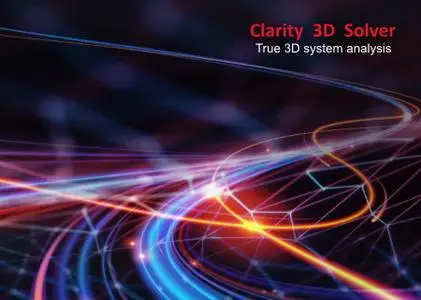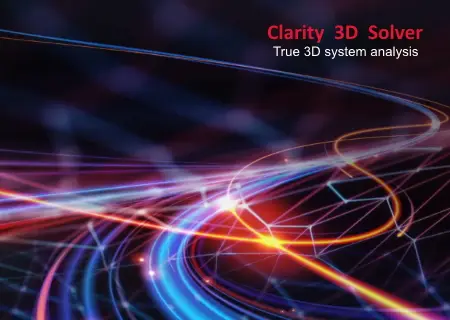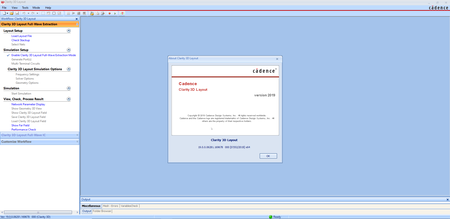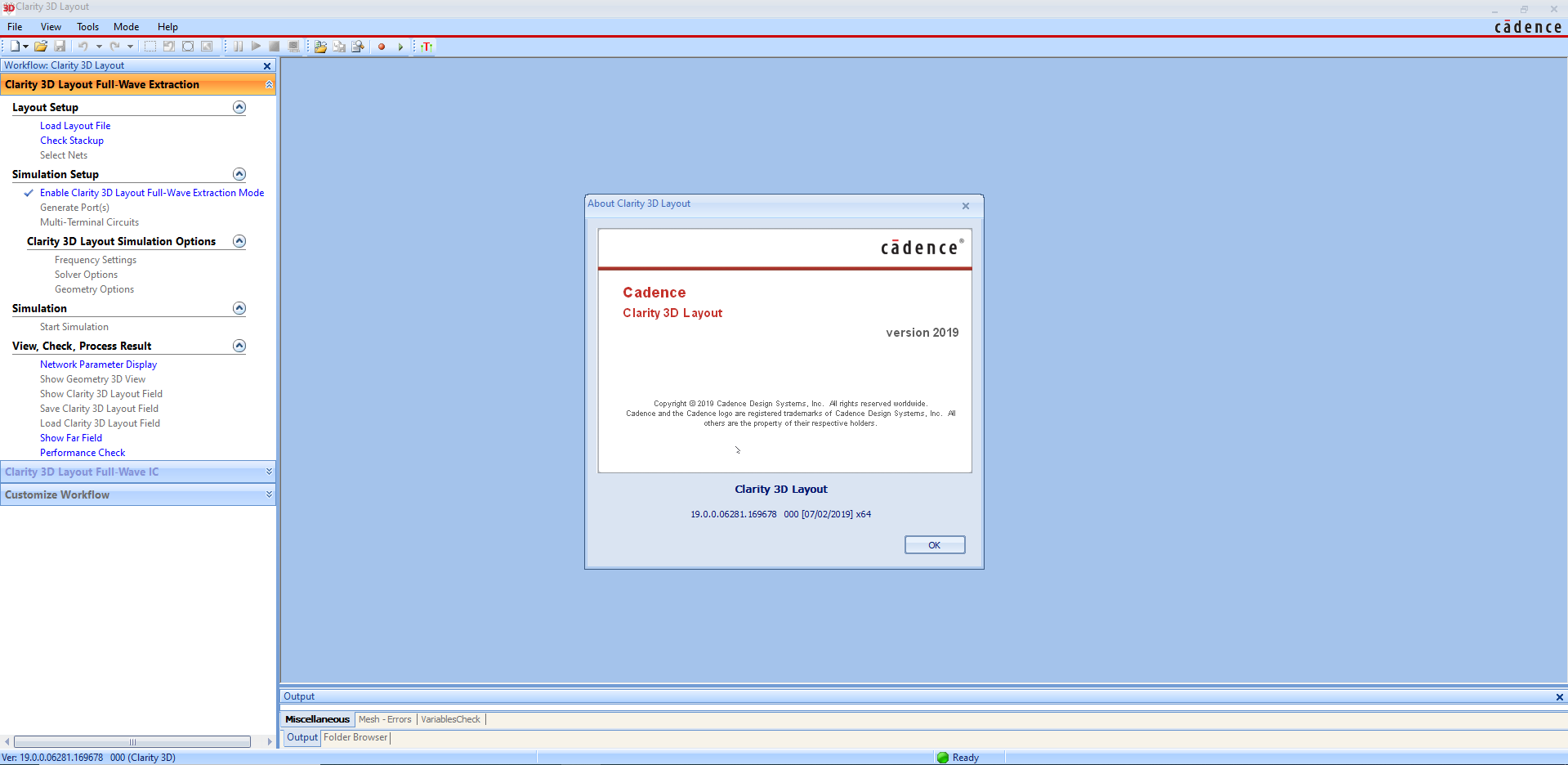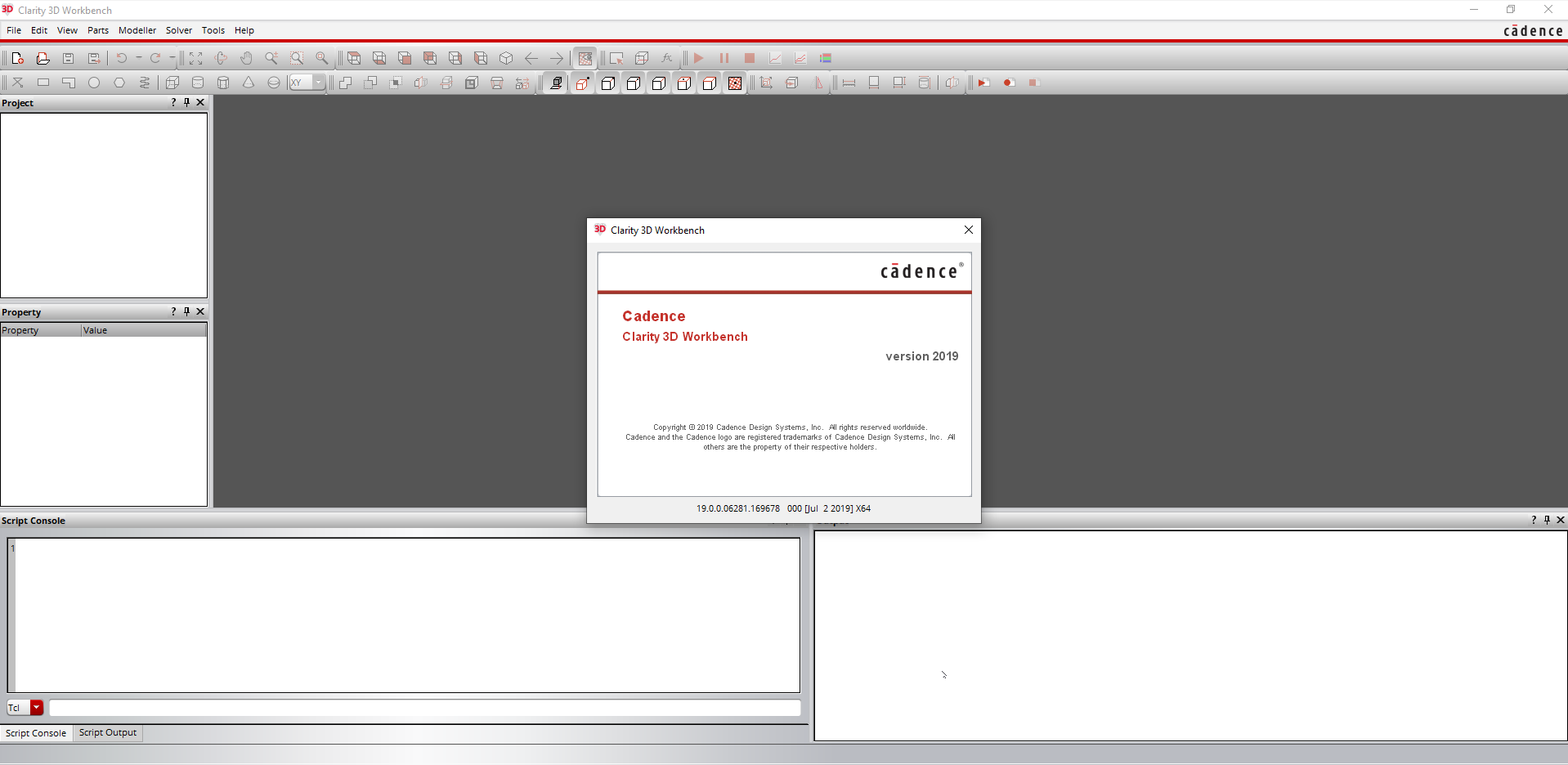Cadence Clarity 2019 version 19.00.000 | 4.2 Gb
Cadence Design Systems, Inc. entered the fast-growing system analysis and design market with the announcement of the Cadence Clarity 3D Solver, which delivers gold-standard accuracy with up to 10X faster simulation performance and unbounded capacity compared to legacy field solver technology.
Harnessing state-of-the-art distributed multiprocessing technology, the Clarity 3D Solver efficiently tackles electromagnetic (EM) challenges encountered when designing complex 3D structures on chips, packages, PCBs, connectors and cables—bringing true 3D analysis to any engineer with desktop, high-performance computing (HPC) or cloud computing resources. The Clarity 3D Solver easily reads design data from all standard chip, IC package and PCB implementation platforms while also providing unique integration benefits for design teams using the Cadence Allegro and Virtuoso implementation platforms.
Highly complex structures found in silicon interposers, rigid-flex PCBs and stacked-die IC packages must be modeled accurately in 3D for structure optimization and high-speed signaling compliance. High-speed signaling, such as in 112G serializer/deserializer (SerDes) interfaces, relies on high-fidelity interconnect design. Any slight change in impedance can negatively impact bit error rate, so optimization entails extensive research including dozens of complex extractions and simulations. To accommodate this workload, legacy field solvers must run on massive, expensive high-performance servers. In addition, speed and capacity limitations of legacy field solver technology require users to carefully simplify and/or partition the structure into smaller segments to fit within local computing constraints. This pseudo-3D approach creates the risk that the resulting final model may contain inaccuracies due to artificial effects from the superficial model boundaries.
Clarity 3D Solver technology addresses the most complex EM challenges faced when designing systems for 5G communications, automotive/ADAS, HPC and IoT applications. Industry-leading Cadence distributed multiprocessing technology enables the Clarity 3D Solver to deliver virtually unlimited capacity and a 10X speed up required to efficiently and effectively address these larger and more complex structures. The Clarity 3D Solver creates highly accurate S-parameter models for use in signal integrity (SI), power integrity (PI) and electromagnetic compatibility (EMC) analysis, enabling simulation results that match lab measurement.
The Clarity 3D Solver is optimized to distribute a job across multiple low-cost computers while remaining equally efficient when running on a more powerful and expensive server with terabytes of memory. A unique distributed adaptive meshing approach and significantly smaller memory requirements than legacy 3D field solvers enable the Clarity 3D Solver to extensively utilize cost-effective cloud and on-premises distributed computing. These advantages make the cloud-ready Clarity 3D Solver an ideal choice to optimize a company’s cloud computing budget.
Using the Clarity 3D Solver in conjunction with the Cadence Sigrity 3D Workbench, users can merge mechanical structures such as cables and connectors with their system design and model the electrical-mechanical interconnect as a single model. The Clarity 3D Solver is also tightly integrated with the Virtuoso, Cadence SiP Layout and Allegro implementation platforms, enabling 3D structures to be designed in the Allegro and Virtuoso environments, optimized in the analysis tool and implemented in the design tool without being redrawn.
What’s New in Clarity 2019 - Date: July 2019
New Products
Added In this release, the following new products have been added:
Clarity 3D Solver
In this release, a new product, Clarity 3D Solver, has been introduced that is designed for electromagnetic and power electronics analysis and simulation, and provides considerable performance improvement on electromagnetic simulation, near-linear scalability, and true 3D system analysis.
Usually, large structures are manually cut into smaller structures for analysis using the largest and most powerful computing resources. However, Clarity 3D Solver uses multi-core computing resources by parallelizing the mathematical tasks required to solve the 3D structures. The tasks can be parallelized within one computer's cores or across multiple computers, thereby considerably reducing the time to solve complex structures.
Clarity 3D Solver uses the industry-leading parallelization technology to ensure that both meshing and frequency sweeping can be partitioned and parallelized across as many computers, computer configurations, and cores as are available. The time required by the solver is scalable, based on the number of computer cores. If you double the number of computer cores, performance will be nearly doubled as well.
Clarity 3D Solver includes the Clarity 3D Layout and Clarity 3D Workbench GUI tools that you can use to design critical interconnects for PCBs, IC packages, and system on IC (SoIC) designs.
Clarity 3D Layout
Clarity 3D Layout is designed for S-parameter model extraction for power-integrity (PI) and signal-integrity (SI) analysis for IC package and PCB designs. The adaptive finite element mesh (FEM) refinement technology provides consistent accuracy for complicated 3D structures. With Clarity 3D Layout, you can easily import the Cadence PCB and ICP file formats, as well as industry-standard file formats, such as IPC2581.
Clarity 3D Workbench
Clarity 3D Workbench enables you to import mechanical structures, such as cables and connectors, and merge them with the PCB so that critical 3D structures that cross from the board to the connector can be modeled and optimized as one structure. You can easily import industry-standard mechanical file formats, such as STEP in Clarity 3D Workbench.
In this release, a new product, Clarity 3D Solver, has been introduced that is designed for electromagnetic and power electronics analysis and simulation, and provides considerable performance improvement on electromagnetic simulation, near-linear scalability, and true 3D system analysis.
Usually, large structures are manually cut into smaller structures for analysis using the largest and most powerful computing resources. However, Clarity 3D Solver uses multi-core computing resources by parallelizing the mathematical tasks required to solve the 3D structures. The tasks can be parallelized within one computer's cores or across multiple computers, thereby considerably reducing the time to solve complex structures.
Clarity 3D Solver uses the industry-leading parallelization technology to ensure that both meshing and frequency sweeping can be partitioned and parallelized across as many computers, computer configurations, and cores as are available. The time required by the solver is scalable, based on the number of computer cores. If you double the number of computer cores, performance will be nearly doubled as well.
Clarity 3D Solver includes the Clarity 3D Layout and Clarity 3D Workbench GUI tools that you can use to design critical interconnects for PCBs, IC packages, and system on IC (SoIC) designs.
Clarity 3D Layout
Clarity 3D Layout is designed for S-parameter model extraction for power-integrity (PI) and signal-integrity (SI) analysis for IC package and PCB designs. The adaptive finite element mesh (FEM) refinement technology provides consistent accuracy for complicated 3D structures. With Clarity 3D Layout, you can easily import the Cadence PCB and ICP file formats, as well as industry-standard file formats, such as IPC2581.
Clarity 3D Workbench
Clarity 3D Workbench enables you to import mechanical structures, such as cables and connectors, and merge them with the PCB so that critical 3D structures that cross from the board to the connector can be modeled and optimized as one structure. You can easily import industry-standard mechanical file formats, such as STEP in Clarity 3D Workbench.
Celsius System Thermal Solution
Thermal analysis is critical for predicting the effect of temperature distribution on the design of integrated circuits (ICs), packages, and PCBs. With decreasing product size and increasing complexity, it is imperative that any thermal compliance issues are detected and resolved early in the design cycle.
Starting with this release, a new product, Celsius System Thermal Solution, has been introduced that provides a unified platform for modeling complex geometries and studying the effect of airflow and heat transfer in and around these geometries.
The Celsius System Thermal Solution provides the following features:
Choice of Solver Engines
Celsius System Thermal Solution offers the following choices of solver engines:
- Field Solver: Uses 3D finite element method (FEM) analysis to solve electrical and thermal equations for solid components and finite volume method (FVM) to solve Navier-Stokes equations for fluid areas of the design.
- Network Solver: Connects electrical, thermal, and flow models extracted from various components of the design.
ECAD/MCAD Creation and Import
- Create, edit, or import 3D mechanical models.
- Repair 3D geometry problems and misalignment errors with Celsius model clean-up functions.
- Import PKG and/or PCB designs and make necessary modifications.
Separate Interfaces for Modeling Different Aspects of Design
Celsius System Thermal Solution has a clearly structured interface with the following modules:
- Solid Objects Simulation for 3D Structures
- Solid Objects Simulation for Layered Structures
- Fluid Flow Simulation
- Thermal Network Simulation
Each module is tailored to model and simulate different aspects of designs including solid objects or fluid flow. Thermal models are extracted from the solid components of the design and from the airflow or fluid flow environment. These models are then assembled ogether into a thermal network that accurately represents the thermal behavior of the system.
These different approaches let you accurately simulate large systems while retaining the granularity of any object of interest.
Multiple Simulation Workflows
Celsius provides multiple workflow choices to help you model and simulate the electrical and thermal effects in solid components with FEM. The E/T co-simulation iterates on the vital interactions between temperature and current flow. This makes it easy to confirm that the design has met specified temperature, voltage, and current density thresholds. You can also model and simulate fluid flow (airflow) and thermal radiation with the integrated CFD extension.
Support for Distributed Computing
Celsius exploits distributed computing based on multiple machines and uses divide-and-conquer approach for analyzing large designs. You can define resources based on your machine setup, to achieve unprecedented performance speed-up and reduce per-machine memory consumption, when simulating your designs.
Integration with Voltus (Chip Power Sign-off Tool)
With Voltus, for a chip, you can have chip geometry information, layered routing information, and chip power and current model. Celsius uses this information as input along with material setups and performs thermal analysis
Detection of Potential Reliability Issues
Identify potential reliability issues due to thermal stress and strain in solid materials with different coefficients of thermal expansion.
Thermal analysis is critical for predicting the effect of temperature distribution on the design of integrated circuits (ICs), packages, and PCBs. With decreasing product size and increasing complexity, it is imperative that any thermal compliance issues are detected and resolved early in the design cycle.
Starting with this release, a new product, Celsius System Thermal Solution, has been introduced that provides a unified platform for modeling complex geometries and studying the effect of airflow and heat transfer in and around these geometries.
The Celsius System Thermal Solution provides the following features:
Choice of Solver Engines
Celsius System Thermal Solution offers the following choices of solver engines:
- Field Solver: Uses 3D finite element method (FEM) analysis to solve electrical and thermal equations for solid components and finite volume method (FVM) to solve Navier-Stokes equations for fluid areas of the design.
- Network Solver: Connects electrical, thermal, and flow models extracted from various components of the design.
ECAD/MCAD Creation and Import
- Create, edit, or import 3D mechanical models.
- Repair 3D geometry problems and misalignment errors with Celsius model clean-up functions.
- Import PKG and/or PCB designs and make necessary modifications.
Separate Interfaces for Modeling Different Aspects of Design
Celsius System Thermal Solution has a clearly structured interface with the following modules:
- Solid Objects Simulation for 3D Structures
- Solid Objects Simulation for Layered Structures
- Fluid Flow Simulation
- Thermal Network Simulation
Each module is tailored to model and simulate different aspects of designs including solid objects or fluid flow. Thermal models are extracted from the solid components of the design and from the airflow or fluid flow environment. These models are then assembled ogether into a thermal network that accurately represents the thermal behavior of the system.
These different approaches let you accurately simulate large systems while retaining the granularity of any object of interest.
Multiple Simulation Workflows
Celsius provides multiple workflow choices to help you model and simulate the electrical and thermal effects in solid components with FEM. The E/T co-simulation iterates on the vital interactions between temperature and current flow. This makes it easy to confirm that the design has met specified temperature, voltage, and current density thresholds. You can also model and simulate fluid flow (airflow) and thermal radiation with the integrated CFD extension.
Support for Distributed Computing
Celsius exploits distributed computing based on multiple machines and uses divide-and-conquer approach for analyzing large designs. You can define resources based on your machine setup, to achieve unprecedented performance speed-up and reduce per-machine memory consumption, when simulating your designs.
Integration with Voltus (Chip Power Sign-off Tool)
With Voltus, for a chip, you can have chip geometry information, layered routing information, and chip power and current model. Celsius uses this information as input along with material setups and performs thermal analysis
Detection of Potential Reliability Issues
Identify potential reliability issues due to thermal stress and strain in solid materials with different coefficients of thermal expansion.
Learn about how the new cloud-ready Clarity 3D Solver lets you optimize your design for true 3D system analysis. This electromagnetic (EM) solver addresses complex 3D structures on chips, packages, and PCBs, creating highly accurate S-parameter models for use in signal integrity (SI), power integrity (PI), and electromagnetic compliance (EMC) analysis. This new EM solver delivers up to 10X performance for electromagnetic simulation with unbounded capacity and gold-standard accuracy.
Cadence enables electronic systems and semiconductor companies to create the innovative end products that are transforming the way people live, work and play. Cadence® software, hardware and semiconductor IP are used by customers to deliver products to market faster. The company’s System Design Enablement strategy helps customers develop differentiated products – from chips to boards to systems – in mobile, consumer, cloud datacenter, automotive, aerospace, IoT, industrial and other market segments. Cadence is listed as one of FORTUNE Magazine’s 100 Best Companies to Work
Product: Cadence Clarity
Version: 2019 version 19.00.000
Supported Architectures: x64
Website Home Page : www.cadence.com
Language: english
System Requirements: PC *
Supported Operating Systems: *
Size: 4.2 Gb
System Requirements:
OS:Microsoft Windows 7 all versions (64-bit), Windows 10 (64-bit), Windows 2012 Server (All service packs), Windows 2016 Server (All service packs).
Note:Note: Clarity 3D Solver and Celsius with Hyper-V are not supported on Windows 7.
CPU:Intel Core i7 4.30 GHz or AMD Ryzen 7 4.30 GHz with at least 4 cores
RAM:8 GB RAM / 64 GB RAM or higher
Space:50 GB free disk space / 500 GB free disk space SSD is recommended for primary operating system (OS) and simulation working directory
Internet:Microsoft Internet Explorer 9.0 or later
Display:1,024 x 768 display resolution with true color (16bit color) / Large monitor (or two) with Full HD resolution or higher
GPU:Dedicated graphics card with 1 GB video memory or higher
OS:Microsoft Windows 7 all versions (64-bit), Windows 10 (64-bit), Windows 2012 Server (All service packs), Windows 2016 Server (All service packs).
Note:Note: Clarity 3D Solver and Celsius with Hyper-V are not supported on Windows 7.
CPU:Intel Core i7 4.30 GHz or AMD Ryzen 7 4.30 GHz with at least 4 cores
RAM:8 GB RAM / 64 GB RAM or higher
Space:50 GB free disk space / 500 GB free disk space SSD is recommended for primary operating system (OS) and simulation working directory
Internet:Microsoft Internet Explorer 9.0 or later
Display:1,024 x 768 display resolution with true color (16bit color) / Large monitor (or two) with Full HD resolution or higher
GPU:Dedicated graphics card with 1 GB video memory or higher
Please visit my blog
Added by 3% of the overall size of the archive of information for the restoration
No mirrors please
Added by 3% of the overall size of the archive of information for the restoration
No mirrors please


